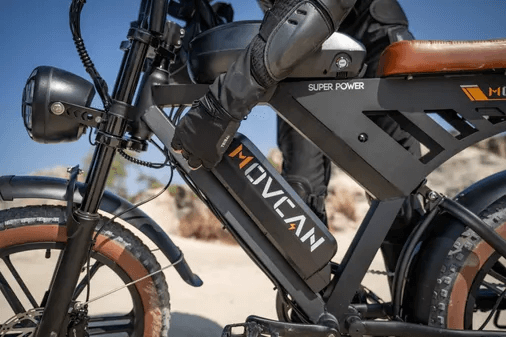If you're the proud owner of an e-bike, you already know the convenience and environmental benefits it offers. But to keep your e-bike performing at its best, one thing stands above all: proper battery care. Whether you’re a new rider or a seasoned enthusiast, understanding the right way to charge your e-bike battery can greatly extend its lifespan and performance. In this guide, we’ll walk you through essential e-bike battery charging tips, answering common questions and providing actionable advice to keep your battery healthy and your rides smooth.
Why Proper Charging Is Essential for Your E-Bike Battery's Longevity?
Before diving into the specifics, let's talk about why following proper e-bike battery charging tips is critical. The way you charge and care for your battery impacts not just the lifespan of the battery, but also your bike's performance on every ride. If you consistently overcharge or undercharge your battery, it can lead to faster degradation, meaning you'll need a costly replacement much sooner than you'd like.
Think of your e-bike battery as the heart of your ride—taking care of it keeps your e-bike functioning like new for a longer period.
E-Bike Battery Charging Tips for New Riders
If you're new to e-bikes, you might be wondering where to start with charging your e-bike battery. Don't worry—it's simple once you get the hang of it!
-
Charge It Correctly the First Time: When you get a new e-bike, the first charge is crucial. Follow the manufacturer's instructions carefully, which usually recommend charging the battery fully before your first ride.
-
Don't Wait Until It's Fully Drained: Unlike older battery types, modern lithium-ion batteries (commonly used in e-bikes) don't have "memory." That means you don't need to wait for them to be fully discharged before charging. Instead, it's better to charge your battery when it hits around 20-30%, ensuring you never fully drain it.
-
Keep It Between 80-90% Charged: You don't always need to charge your battery to 100%. Regularly charging it to around 80-90% can actually prolong its life. Why? Charging to 100% all the time places extra strain on the battery, speeding up degradation over time.
Dos and Don'ts of Charging Your E-Bike Battery
Here are some dos and don'ts to keep in mind for optimal charging habits.
Dos:
- Charge after each ride: It's a good habit to charge your e-bike battery after every ride, especially if it’s down to 20-30%. This helps maintain battery health.
- Charge in a cool, dry place: Heat is the enemy of battery health. Always charge your battery in a cool, dry place to prevent overheating.
- Unplug when fully charged: Overcharging your e-bike battery can shorten its lifespan, so make sure to unplug the charger once it’s fully charged. Some newer chargers automatically stop once the battery is full, but it's still good practice to keep an eye on it.
Don'ts:
- Avoid charging in extreme temperatures: Whether too hot or too cold, extreme temperatures can damage the battery cells. Don't charge your battery in direct sunlight or freezing environments.
- Don't let it discharge completely: Running your e-bike battery down to 0% regularly can cause lasting damage. Charge it before it gets too low to avoid unnecessary strain.
- Never leave it charging overnight: Leaving your battery plugged in overnight, especially in uncontrolled environments, can lead to overcharging and long-term damage.
How to Prolong Your E-Bike Battery Life Through Proper Charging?
Prolonging your eBike battery's life isn't just about how you charge it—it's about how you store and care for it long-term. Follow these best practices to get the most out of your battery.
-
Avoid Full Discharges and Rapid Charges: Modern lithium-ion batteries don't need to be fully discharged before charging. In fact, letting the battery dip too low or using rapid chargers frequently can reduce its lifespan.
-
Store It at the Right Charge Level: If you're not going to use your e-bike for a while, it's important to store the battery with a partial charge. Experts recommend keeping it at about 40-60% charged. Storing a fully charged or completely drained battery for extended periods can cause it to degrade faster.
-
Use the Right Charger: Always use the manufacturer-recommended charger. Using third-party or cheap alternatives can affect your battery's performance and even cause it to fail prematurely.
Insights for Long-Distance Riders or Frequent Users
If you're someone who regularly goes on long rides or uses your e-bike for commuting, your charging needs are a bit different:
- Plan Charging Stops: For longer rides, it's important to plan out places where you can top off your battery. Many cafes or rest stops offer outlets where you can charge for a bit.
- Carry a Portable Charger: Having a portable charger can help in a pinch, allowing you to charge on the go.
- Consider a Spare Battery: Long-distance riders might benefit from a second battery to extend their range. Be sure to alternate between batteries to avoid overuse of one.
- Charge Smartly After Long Rides: After a long ride, let the battery cool down before plugging it in to avoid charging when the cells are hot, which can reduce efficiency.
Temperature Considerations for Charging Your E-Bike Battery
Temperature is a major factor that affects battery performance and lifespan. Here’s what you need to know about charging in various conditions:
-
Ideal Charging Temperature: The optimal temperature for charging your e-bike battery is between 50°F and 77°F (10°C and 25°C). Charging in this range will help your battery charge efficiently and avoid excess strain.
-
Charging in Cold Weather: If you're riding in cold climates, it's best to bring your battery indoors to charge. Charging a frozen or very cold battery can cause permanent damage. Wait until the battery reaches room temperature before plugging it in.
-
Charging in Hot Weather: Similarly, extreme heat can degrade your battery. Don't leave your e-bike battery in direct sunlight or inside a hot car, as high temperatures can harm the internal cells. If your battery feels hot to the touch after a ride, allow it to cool down before charging.
Best Practices for Charging E-Bike Batteries During Storage
Properly storing your battery when not in use is critical to its longevity, especially if you're planning on taking a break from riding during the off-season.
- Partially Charged Storage: As mentioned earlier, store your battery with a partial charge (around 40-60%) if you don’t plan to use it for a few weeks or months. Batteries that are stored either fully charged or fully discharged can suffer from cell degradation.
- Check Battery Levels Periodically: If your bike is stored for several months, check the battery every few months and charge it back up to 40-60% if it drops below that level.
- Keep It Cool and Dry: Store the battery in a temperature-controlled environment. Avoid humid spaces or places where the battery could get wet.
Fast Charging vs. Slow Charging: Which is Better for Your E-Bike Battery?
When it comes to charging speed, you might be wondering if fast charging is worth the convenience, or if it’s better to stick with the slow, standard method.
- Fast Charging: While fast chargers can get your e-bike battery ready in less time, they place additional strain on the battery’s cells, which can reduce its lifespan if used frequently. Fast charging is fine in a pinch, but avoid making it your go-to method.
- Slow Charging: For everyday use, slow charging is the better option. It’s gentler on the battery and helps maintain its overall health over the long term.
If you're not in a rush, always opt for slow charging to keep your battery in peak condition.
Regular Battery Inspection and Maintenance
Along with proper charging habits, it's important to inspect your battery regularly to keep it in good working condition.
- Check for Physical Damage: Regularly inspect your battery for signs of wear or damage, like dents or corrosion around the terminals.
- Clean the Contacts: Use a dry cloth to clean the battery contacts to ensure a good connection. Dust and dirt can interfere with charging efficiency.
- Check for Software Updates: Many e-bikes come with smart batteries that may require software updates. Stay updated on manufacturer alerts to ensure your battery is functioning at its best.
Avoid Common Charging Mistakes That Could Damage Your E-Bike Battery
Avoiding these common mistakes can save you from unnecessary repairs and battery replacements:
- Using the Wrong Charger: Always use the charger that comes with your e-bike or one recommended by the manufacturer. Third-party chargers can overcharge or undercharge your battery, leading to performance issues.
- Leaving the Battery Plugged In: Overcharging is a major cause of premature battery failure. Even if your charger stops charging when the battery reaches 100%, leaving it plugged in for extended periods isn’t recommended.
- Ignoring Battery Health During Storage: Forgetting to periodically check your battery’s charge level during long storage periods can leave you with a drained and damaged battery. Make it a habit to check in every couple of months.
Bike Battery Charging Tips: A Handy Checklist
To make things easier, here's a summary checklist of bike battery charging tips to keep your battery performing at its best:
- ✅ Charge in a cool, dry place.
- ✅ Unplug the charger once the battery reaches full charge.
- ✅ Don’t wait for the battery to fully discharge—charge at around 20-30%.
- ✅ Partial charging (80-90%) is better for daily use.
- ✅ Store batteries at 40-60% charge when not in use.
- ✅ Avoid charging in extreme temperatures.
- ✅ Use only the manufacturer-recommended charger.
- ✅ Inspect the battery for damage and clean the contacts regularly.
- ✅ Avoid using quick chargers frequently.
FAQs About E-Bike Battery Charging for Better Performance
Q1: Can I leave my e-bike battery plugged in overnight?
While some chargers stop charging once the battery is full, it's best to unplug your battery once it’s fully charged to avoid potential overcharging.
Q2: How often should I charge my e-bike battery?
It’s a good idea to charge your battery after every ride if it drops below 30%. Try to avoid fully discharging the battery regularly.
Q3: Is it okay to charge my e-bike battery after every ride?
Yes, especially if you’ve used a significant portion of the battery. Keeping it between 20-90% charged is ideal for maintaining its health.
Q4: Can I use any charger for my e-bike battery?
No, it’s essential to use the charger that’s designed for your specific battery. Using a generic charger can damage the battery or affect its performance.
Conclusion: Follow These E-Bike Battery Charging Tips for Long-Lasting Performance
Taking good care of your e-bike battery isn’t difficult, but it does require some attention to detail. By following these e-bike battery charging tips, you can ensure that your battery stays in top shape for years to come. From charging at the right time to storing your battery correctly during off-seasons, these simple steps can make a world of difference in your bike's performance.
Remember, a well-maintained battery not only improves your e-bike’s range and power but also saves you money in the long run by extending its lifespan. So, whether you're new to e-bikes or looking to fine-tune your charging habits, these tips will keep you on the road longer and with better performance.Got it! I'll make sure to follow those guidelines moving forward. Let me know how you'd like to proceed or if you need further assistance!




Share:
Why Do You Have to Pedal an Electric Bike?
Electric Bike Gears Not Working? A Comprehensive Troubleshooting Guide